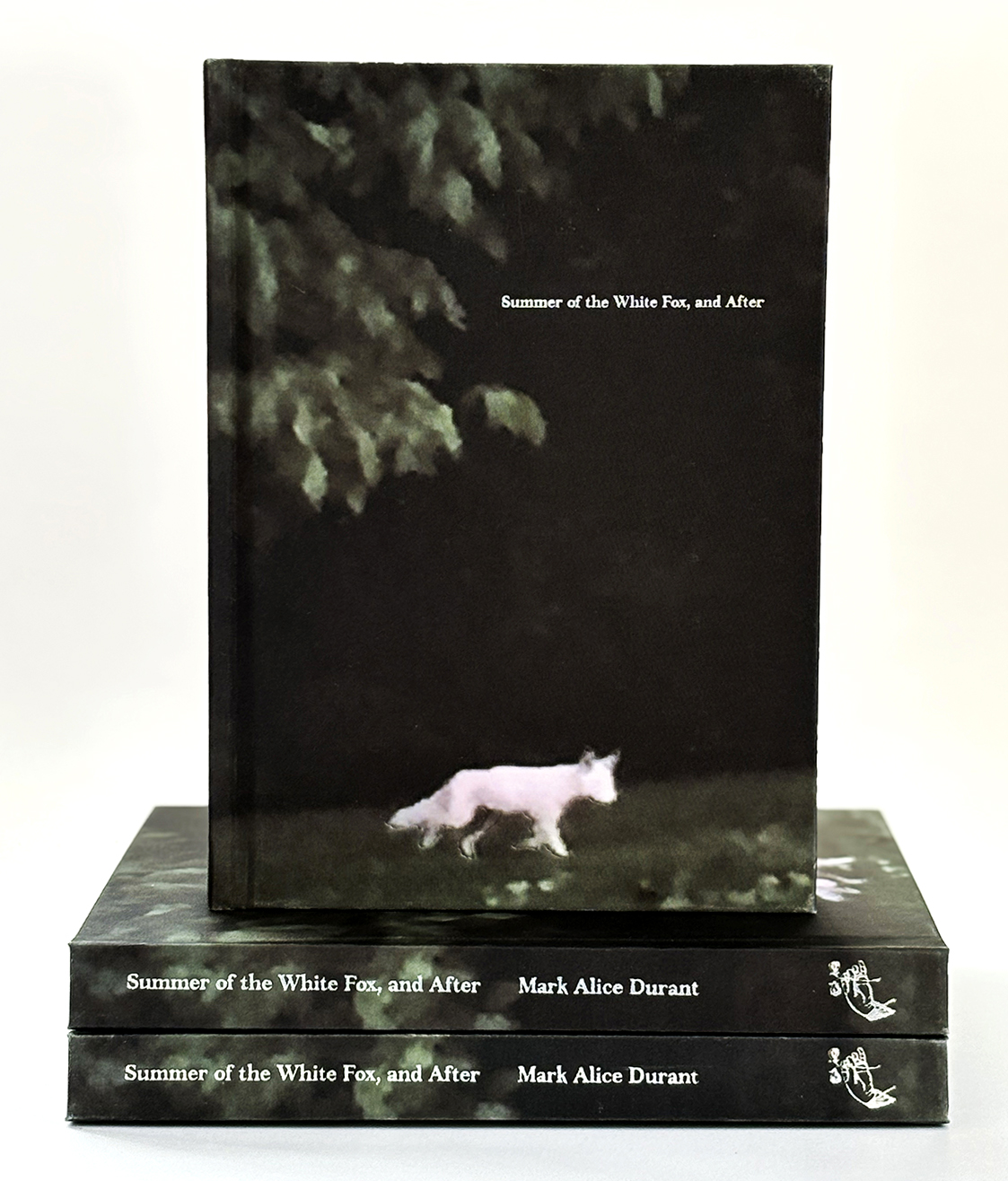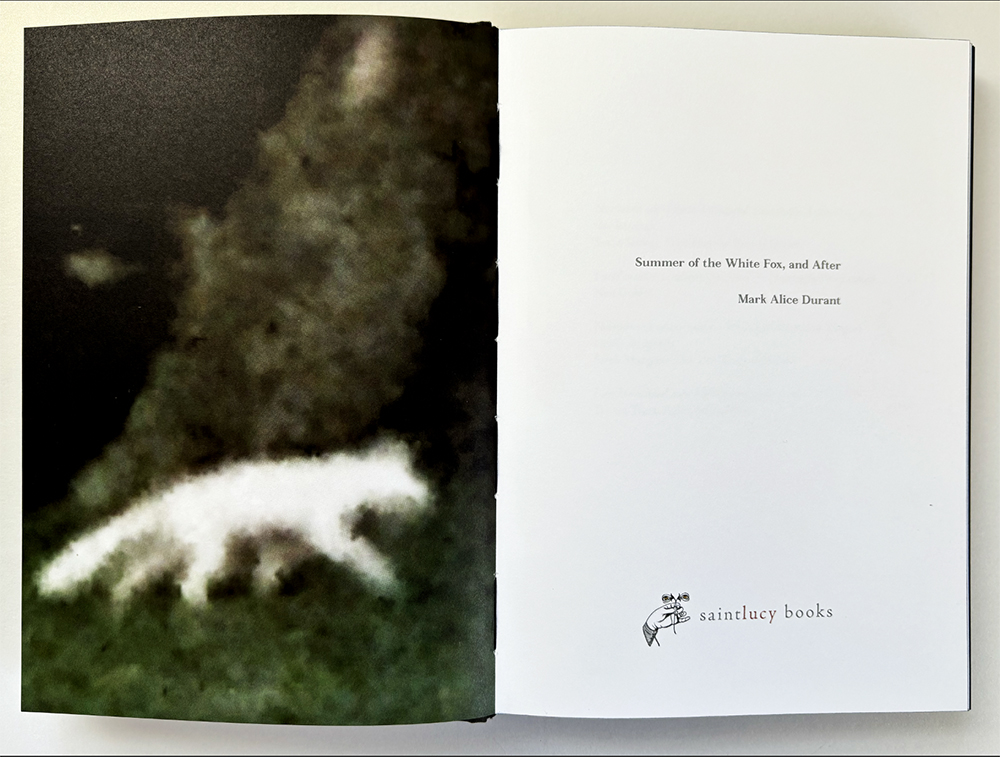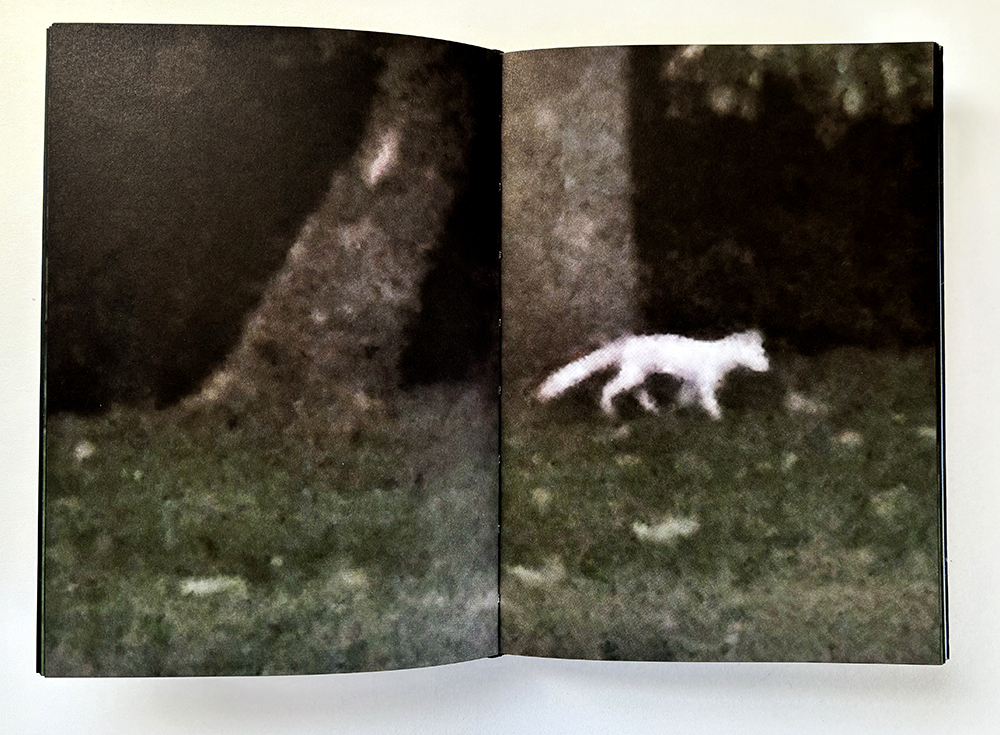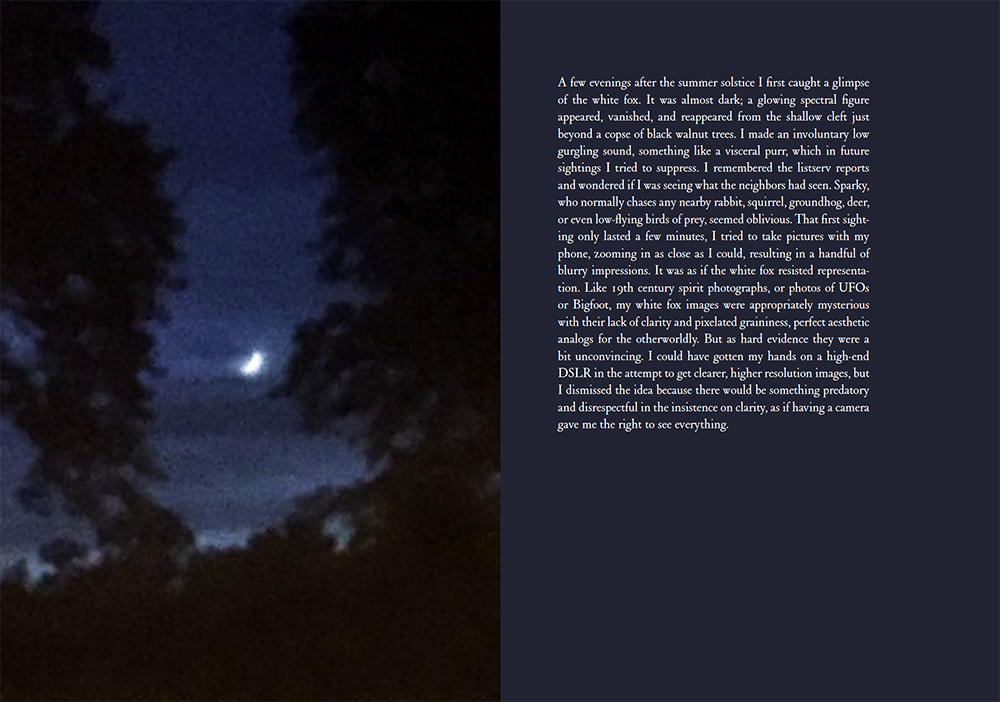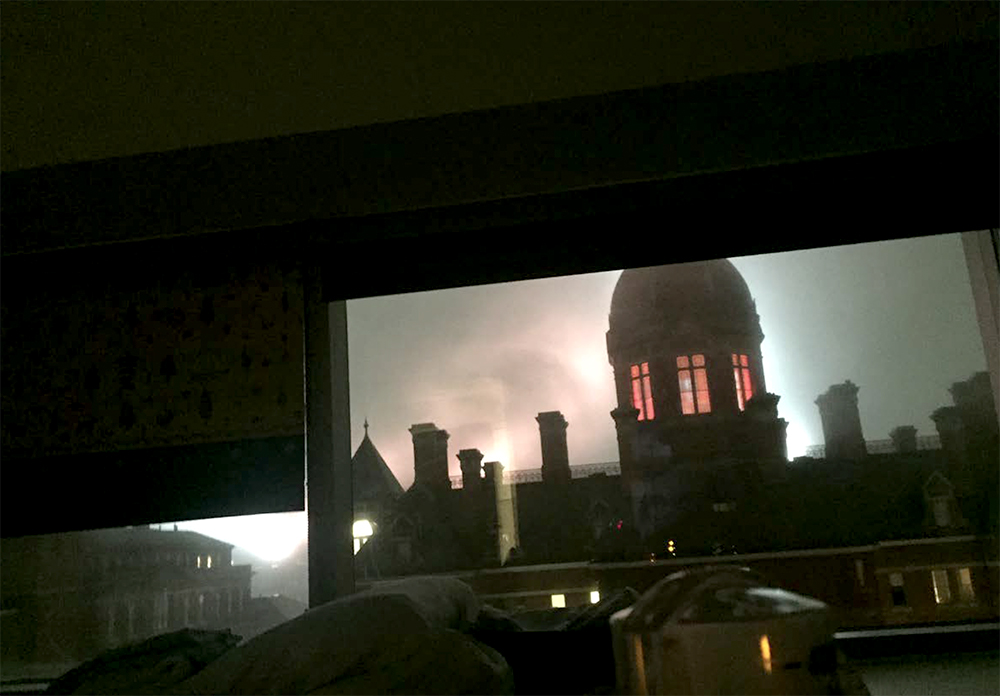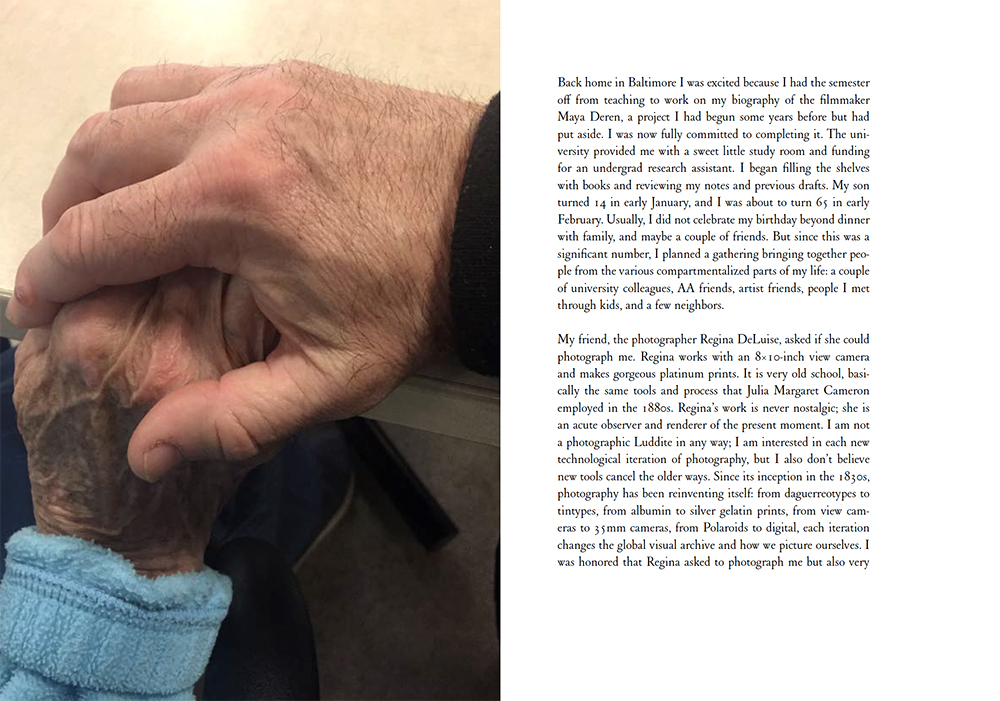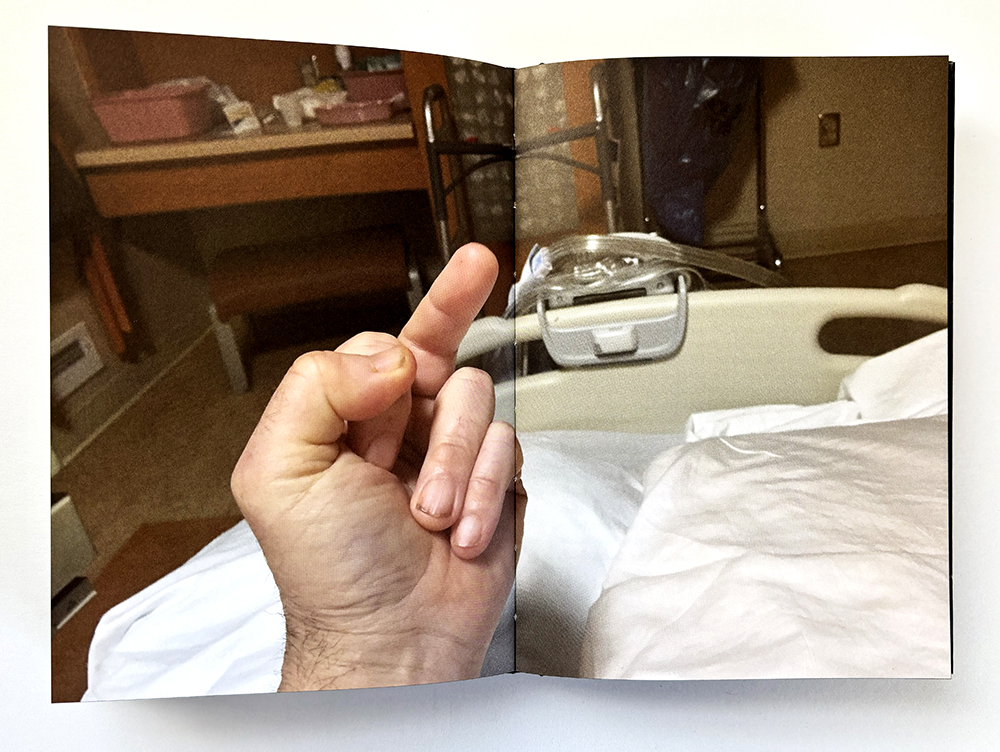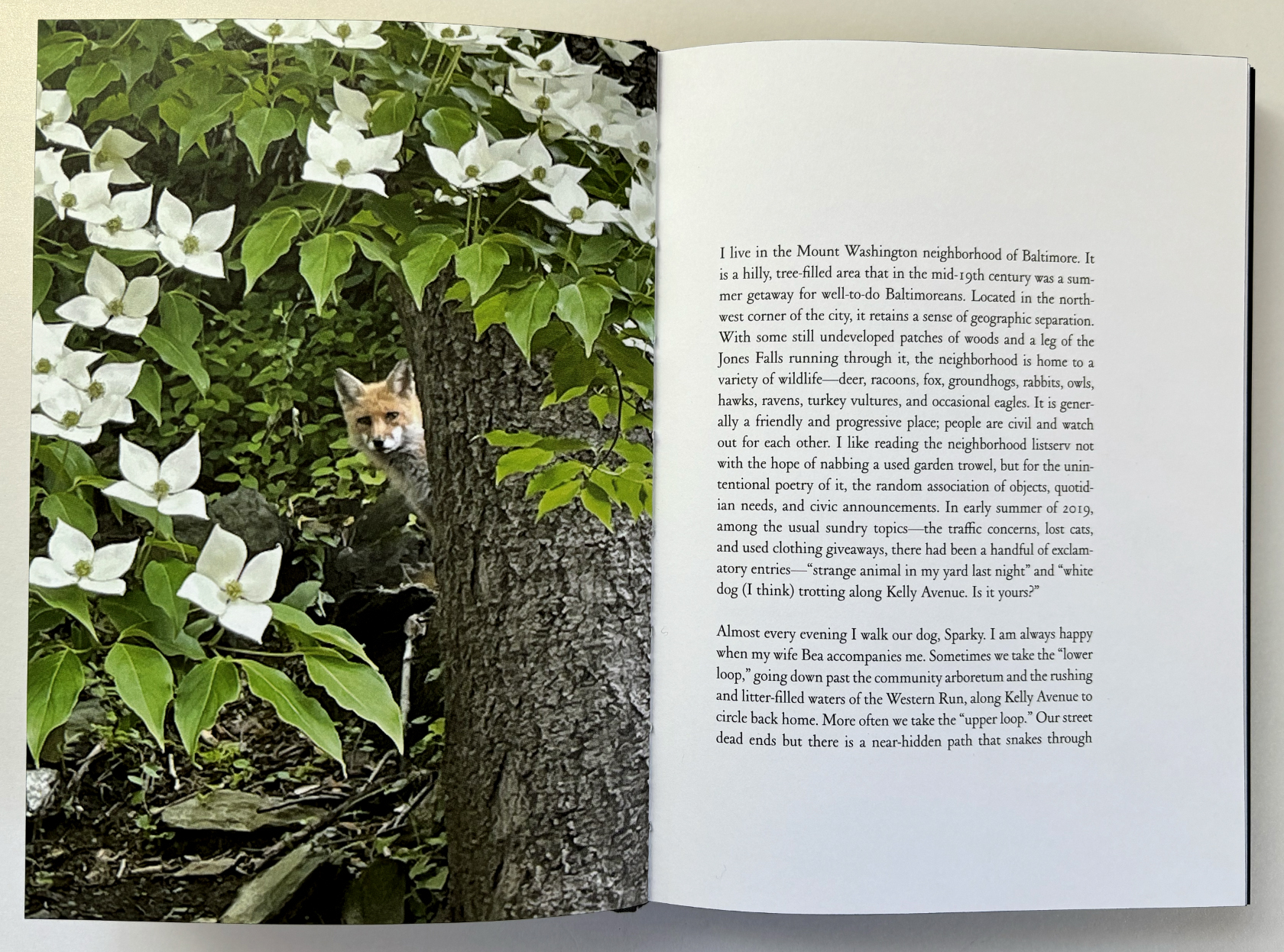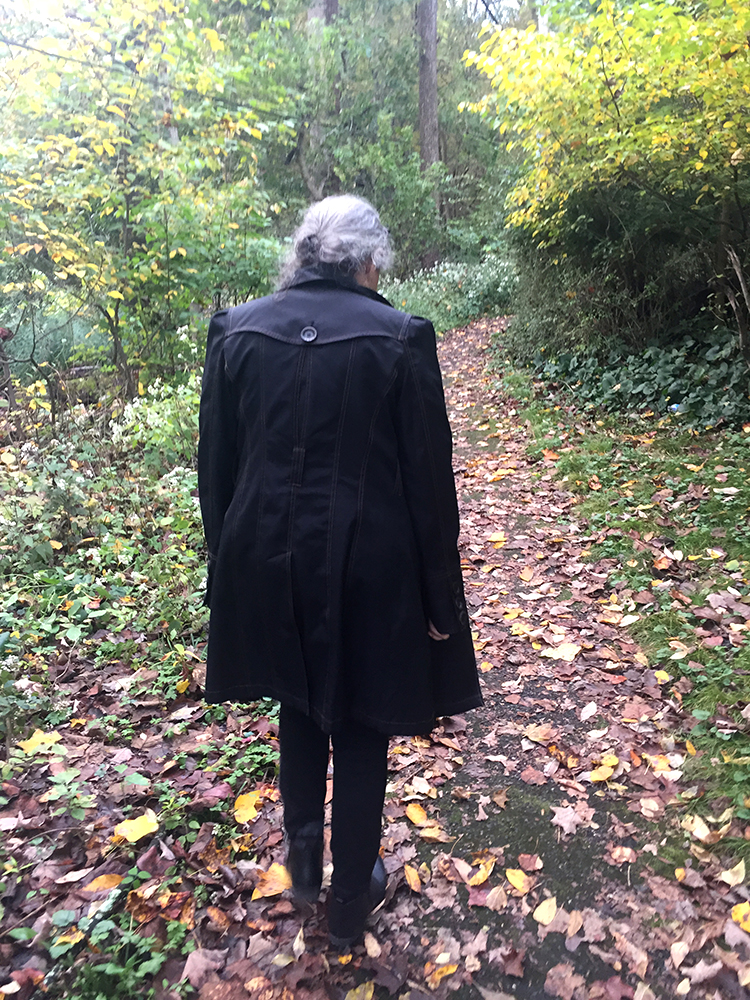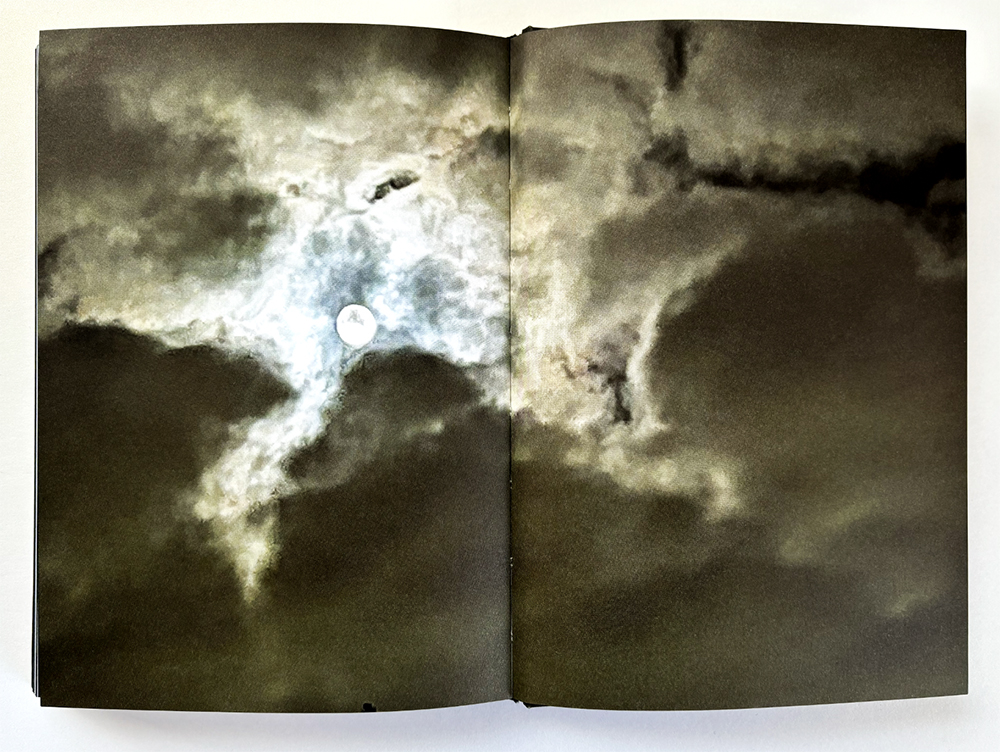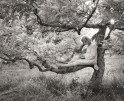Mark Alice Durant: Summer of the White Fox, and After
Illness, death, and grief are among the most ubiquitous of human experiences and yet they are the most challenging to untangle, let alone make public. In his book Summer of the White Fox, and After (Saint Lucy Books, 2024), Mark Alice Durant combines image and text to produce a memoir about loss; a book that serves as the black box that carefully details as much information as possible of his own acute illness and the impact of the death of loved ones; experiences that are difficult to make sense of in pictures or words alone. Using the iPhone, the camera in his pocket, to record everyday occurances—the enigma of a white fox that visited his neighborhood in the summer of 2019, walks in nature, and views from his sick bed—Durant has created both a witty and deeply personal account of events that led up to his most difficult days, and after.
For six weeks, in the summer of 2019, a mysterious creature appeared every evening in Durant’s Baltimore neighborhood. Was it a biological anomaly, an apparition, a portentous sign, or all the above? The visitation of this ghostly entity prompted a season of reverie; in the dimming twilight, as the vulpine creature darted in and out sight, Durant reconsidered his own life narratives, and questioned his insatiable desire to photographically capture the otherworldly visitor.
In 2020, as the COVID pandemic forced a global redefinition of our notions of personal safety and collective responsibility, Durant faced his own serious health crisis as well as the illness and death of beloved family members. Durant’s episodic account of his hospitalizations and his dwindling ability to understand what was happening to and around him is as vivid as it is harrowing. Grief, fear, tenderness, wonder, dark humor, and the comforts of art and nature are inextricably bound in this photographic and narrative exploration of trauma and mystical transience.
Sara J. Winston: Summer of the White Fox, and After is groundbreaking. I’m so grateful to you for making this book. Publishing this work seems revolutionary to me. Since 2015 I’ve been hungry for the elusive photobook of an artist’s own experience of illness. Now in 2024, yours has arrived. Thank you for sharing your story, and congratulations on the beautiful book object that contains it.
I admire the way you share the interiority of illness, care, and recovery. Your voice and your courage, both in the writing and the images, makes illness in all its detail a public matter. Your book is one that I wish to engage with over and over again. The analogies and historical referents you braid together communicate what is real yet impossible to comprehend of patienthood until one experiences it firsthand, either as a patient or as a patient advocate.
I’m curious, does the work in book form surprise you? What is it like for you now that the book is out in the world?
Mark Alice Durant: From the very beginning I envisioned a book. In my art career I have made photographs, installations, performances, mixed-media, but I have always been a writer as well. I have never considered making images / writing as mutually exclusive. When I read, I think about language of course, but language evokes mental images. Conversely, when I am making images, whether wandering around with a camera, or collaging in the studio, I am conjuring narratives, or just mentally playing phrases or individual words or even sounds. It is a natural relationship. I have always considered myself an artist and a writer. I started Saint Lucy Books in 2017 to work with other artist / writers to make books that combine words and images in interesting ways.
For six weeks, in the summer of 2019, a mysterious creature appeared every evening in my Baltimore neighborhood. At first, I did not understand what I was seeing. My neighborhood is hilly with lots of trees and some undeveloped patches of land, seeing deer, racoons, hawks, owls, groundhogs, and fox, is common. But this encounter was unprecedented. In the gathering darkness, I saw what seemed to be a white fox darting around the shadows. Was it a biological anomaly, an apparition, a portentous sign, or all the above? The visitation of this ghostly entity prompted a season of reverie; in the dimming twilight, as the vulpine creature darted in and out sight, it prompted me into a contemplative period, that lasted through the autumn, in which I reconsidered my own life narratives, and questioned my insatiable desire to photographically capture the otherworldly visitor.
In 2020, as the COVID pandemic forced a global redefinition of our notions of personal safety and collective responsibility, I faced my own serious health crisis as well as the illness and death of beloved family members. While convalescing, I was trying to patch together what had happened but because of months on opiates, there were large gaps in my memory. There were weeks and weeks for which I had only vague images and sensations. I was haunted by the lack of narrative, could not seem to move on without constructing a way to represent, even episodically, what had happened. And because so much of what I did remember was hallucinatory, I needed to construct a book of words and images that explored, ironically perhaps, the impossibility of representation. I was impelled to write the book, but knew it would be necessarily incomplete, a phantom narrative, which is why the appearance of the white fox, in the summer of 2019, and my failed attempts to photographically capture it, became the metaphor to examine all of that.
The book includes episodic accounts of my hospitalizations and dwindling ability to understand what was happening to and around me. Grief, fear, tenderness, wonder, dark humor, and the comforts of art and nature are inextricably bound in this photographic and narrative exploration of trauma and mystical transience.
SJW: I often think of the symbiotic relationship of writing propelling pictures and pictures propelling writing, and writing propelling image selection in the process of making a book. Can you describe your working method for Summer of the White Fox, and After?
You mention that your “experience in illness was as irreducible to narrative as the white fox was resistant to description,” yet you’ve built an incredibly clear, while harrowing, picture of the experience for your readers vis-à-vis image and text. When in your recovery were you able to begin the process of writing for the book? Did the writing come to you in segments, fits and starts, or once you began, was it contiguous? How did you know once the book was complete?
MAD: In the summer of 2022, I realized I could not make art or write until I made an attempt to represent what had happened not only to me in 2020, but also my family, and the world at large, during the Covid lockdown. I read Virginia Woolf, Sarah Manguso, Roland Barthes, Joan Didion, Lucille Clifton, looking for strategies, inspiration. I thought a lot about fragmentation, erasure, blank spaces in narrative. I kept looking at the blurry images of the white fox I took in 2019, looked at the weird, inscrutable images I made in my hospital room in the middle of the night, and constructed a litany of fragments, not aphorisms exactly, more like shards of narrative, and then I strung them together in way that I hope is analogous the temporal disorientation and emotional unmooring I experienced in illness. After months of what I call ‘ambient research’ which is essentially reading / listening / looking at anything remotely connected to my themes; I started writing early in the summer and finished by summer’s end. I knew the questions and themes I wanted to explore and how to write along with the imagery. Although there was some minor editing, tweaking of phrases, and word choices, the text came without much distress or uncertainty.
SJW: Can you describe a moment that was particularly challenging to write and one that might have been surprisingly simple?
MAD: Trying to write about my wife’s grief at her sister’s death, and because I was basically incapacitated in my illness, I was unable to comfort her. That was difficult. Initially I thought writing about the white fox would be difficult because I wanted to create a feeling of between-ness, between a kind of documentary witnessing and the hallucinatory aspect of observing something I could not explain and how this vision sparked inchoate feelings and associations. Seeing the white fox in successive evenings cumulatively challenged / changed my perceptual relationship to the world. But once I started writing about the fox in relation to photographs that I had taken of it, I found it thrilling to re-encounter, re-imagine the white fox through the failed images. And by failed, I mean, incomplete, inscrutable, suggesting more mystery than answering any questions.
SJW: I’m struck by the black gilded edges that envelope the book in the night and make the entire wrapping and cast the object as complete night sky with the white fox approaching the fore-edge to walk onto the back cover. Would you tell us about the design choices for the book? Why are some pages in the text block are white, black, and white again?
MAD: A majority of Saint Lucy’s books have been designed by my incredible colleague, Guenet Abraham. I had some urgency to get the White Fox book out into the world and Guenet was very busy with other projects during that time. So I approached Caleb Cain Marcus of Luminosity Lab. I admire his work, especially some titles with Kris Graves Project, and after a conversation at the ICP Photobook Festival in 2023, I asked if he would like to work together and thankfully he was open to it. Caleb and I talked a lot about the feel of the book, its size, paper, and the materials. I wanted a book that was small, intimate, very physical without being too precious. Caleb came up with a bunch of ideas and we went back and forth until we came into agreement. Caleb is especially good with suggesting materials / paper – the haptic aspects of giving a book a unique physicality. The book’s title (and the fox) is debossed into a cloth cover. The title is printed small, like a whisper, my name is not on the cover only the spine. The narrative section in the middle, about the appearance of the white fox, which only appeared in twilight in that summer of 2019, are printed with white ink on midnight-blue paper, to emphasize, materially, the elusive, dreamy, fugitive nature of time when the light of day is fading into a shadow world. The edges of the book are darkened black giving the book a sense that it is also a container, or a small box, holding secrets.
Mark Alice Durant is an artist and writer living in Baltimore. He is author of Summer of the White Fox, and After, Maya Deren, Choreographed for Camera, and 27 Contexts: An Anecdotal History in Photography. His essays have appeared in numerous journals such as Aperture, Art in America, Photograph Magazine, Dear Dave, and many catalogs, monographs, and anthologies including Rania Matar: She, Seeing Science: How Photography Reveals the Universe, and Vik Muniz Seeing is Believing. He has taught at the School of the Art Institute of Chicago, UCLA, University of New Mexico, the Milton Avery Graduate School of the Arts at Bard College, and is currently a professor at the University of Maryland, Baltimore County. Durant is publisher / editor of Saint Lucy Books.
Saint Lucy Books publishes elegant, idiosyncratic, and accessible books that combine words and images to celebrate contemporary photographic artists, and to explore the marginal, hidden, and parallel histories of photography.
Sara J. Winston is an artist and contributor to Lenscratch.
Follow Mark Alice Durant, Saint Lucy Books, and Sara J. Winston on Instagram:
@saint_lucy_books; @sarajwinston
Posts on Lenscratch may not be reproduced without the permission of the Lenscratch staff and the photographer.
Recommended
-
Aaron Rothman: The SierraDecember 18th, 2025
-
Eli Durst: The Children’s MelodyDecember 15th, 2025
-
Kinga Owczennikow: Framing the WorldDecember 7th, 2025
-
Richard Renaldi: Billions ServedDecember 6th, 2025
-
Ellen Harasimowicz and Linda Hoffman: In the OrchardDecember 5th, 2025

